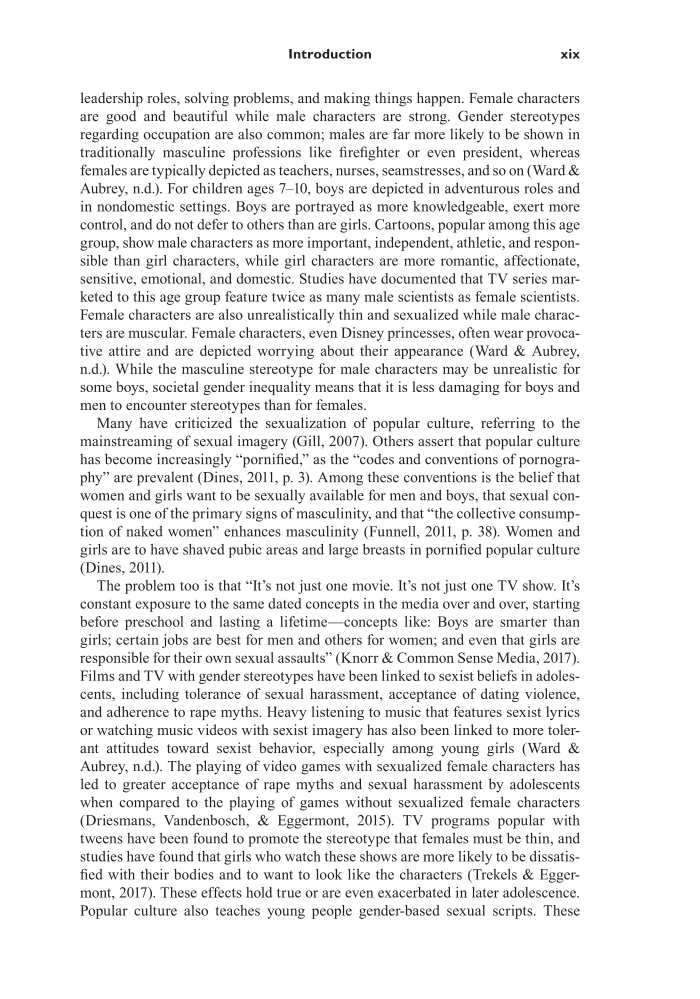Introduction xix leadership roles, solving problems, and making things happen. Female characters are good and beautiful while male characters are strong. Gender stereotypes regarding occupation are also common males are far more likely to be shown in traditionally masculine professions like firefighter or even president, whereas females are typically depicted as teachers, nurses, seamstresses, and so on (Ward &Aubrey, n.d.). For children ages 7–10, boys are depicted in adventurous roles and in nondomestic settings. Boys are portrayed as more knowledgeable, exert more control, and do not defer to others than are girls. Cartoons, popular among this age group, show male characters as more important, independent, athletic, and respon- sible than girl characters, while girl characters are more romantic, affectionate, sensitive, emotional, and domestic. Studies have documented that TV series mar- keted to this age group feature twice as many male scientists as female scientists. Female characters are also unrealistically thin and sexualized while male charac- ters are muscular. Female characters, even Disney princesses, often wear provoca- tive attire and are depicted worrying about their appearance (Ward &Aubrey, n.d.). While the masculine stereotype for male characters may be unrealistic for some boys, societal gender inequality means that it is less damaging for boys and men to encounter stereotypes than for females. Many have criticized the sexualization of popular culture, referring to the mainstreaming of sexual imagery (Gill, 2007). Others assert that popular culture has become increasingly “pornified,” as the “codes and conventions of pornogra- phy” are prevalent (Dines, 2011, p. 3). Among these conventions is the belief that women and girls want to be sexually available for men and boys, that sexual con- quest is one of the primary signs of masculinity, and that “the collective consump- tion of naked women” enhances masculinity (Funnell, 2011, p. 38). Women and girls are to have shaved pubic areas and large breasts in pornified popular culture (Dines, 2011). The problem too is that “It’s not just one movie. It’s not just one TV show. It’s constant exposure to the same dated concepts in the media over and over, starting before preschool and lasting a lifetime—concepts like: Boys are smarter than girls certain jobs are best for men and others for women and even that girls are responsible for their own sexual assaults” (Knorr &Common Sense Media, 2017). Films and TV with gender stereotypes have been linked to sexist beliefs in adoles- cents, including tolerance of sexual harassment, acceptance of dating violence, and adherence to rape myths. Heavy listening to music that features sexist lyrics or watching music videos with sexist imagery has also been linked to more toler- ant attitudes toward sexist behavior, especially among young girls (Ward &Aubrey, n.d.). The playing of video games with sexualized female characters has led to greater acceptance of rape myths and sexual harassment by adolescents when compared to the playing of games without sexualized female characters (Driesmans, Vandenbosch, &Eggermont, 2015). TV programs popular with tweens have been found to promote the stereotype that females must be thin, and studies have found that girls who watch these shows are more likely to be dissatis- fied with their bodies and to want to look like the characters (Trekels &Egger- mont, 2017). These effects hold true or are even exacerbated in later adolescence. Popular culture also teaches young people gender-based sexual scripts. These
Document Details My Account Print multiple pages
Print
You have printed 0 times in the last 24 hours.
Your print count will reset on at .
You may print 0 more time(s) before then.
You may print a maximum of 0 pages at a time.










































































































































































































































































































































































































































































































































































































































































































































































































